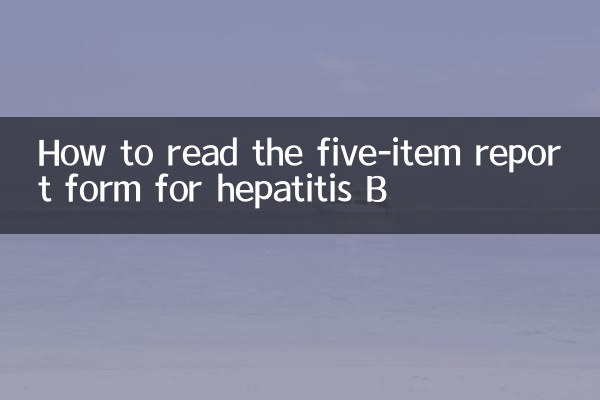How to read the five-item report form for hepatitis B
Five hepatitis B items (two and a half hepatitis B) are commonly used clinical indicators for detecting hepatitis B virus (HBV) infection. Serological testing can determine whether you are infected with hepatitis B virus, the stage of infection, and your immune status. This article will combine the recent hotly discussed health topics on the Internet, structurally analyze the meaning of each of the five hepatitis B report forms, and provide an easy-to-understand interpretation method.
1. Five hepatitis B test items and their clinical significance

| Test items | English abbreviation | normal reference value | Positive meaning |
|---|---|---|---|
| Hepatitis B surface antigen | HBsAg | Negative(-) | Presence of hepatitis B virus infection |
| Hepatitis B surface antibody | HBsAb | Negative/Positive (+) | Have immunity (developed after vaccination or recovery) |
| Hepatitis B e antigen | HBsA | Negative(-) | The virus replicates actively and is highly contagious |
| Hepatitis B e antibody | HB | Negative(-) | Virus replication weakens (needs to be judged in conjunction with other indicators) |
| Hepatitis B core antibody | HBcAb | Negative(-) | Previous infection or current infection (need to differentiate between IgM/IgG) |
2. Interpretation of common combination patterns
According to recent hot discussions on medical forums, the following are the five common combination patterns of hepatitis B in clinical practice and their corresponding clinical states:
| Schema name | HBsAg | HBsAb | HBsA | HB | HBcAb | clinical significance |
|---|---|---|---|---|---|---|
| Dashanyang | + | - | + | - | + | The virus actively replicates and is highly contagious |
| Xiao Sanyang | + | - | - | + | + | The virus replicates slowly, but we need to be wary of mutations |
| recovery period | - | + | - | + | + | Recovery after infection and development of immunity |
| after vaccination | - | + | - | - | - | Immunization successful, no history of infection |
3. Notes on report analysis
Based on the recent popular search content on health science, readers are reminded to pay attention to the following points:
1.False positive possible: The test may be interfered by factors such as hemolysis and lipemia, and needs to be reviewed in combination with liver function and HBV-DNA
2.Window period identification: HBsAg may not be detected 2-6 weeks after infection, and high-risk exposed persons need dynamic monitoring
3.Interpretation of special groups: Pregnant women who are HBsAg positive need to inject immune globulin into their newborns within 12 hours after delivery.
4.Antibody titer: Only HBsAb>10mIU/ml can be protective, and regular review can evaluate the vaccine effect.
4. Expansion of hotspot related knowledge
The "Action Plan to Eliminate the Harm of Hepatitis B" recently released by the National Health Commission has attracted widespread attention. Related content is added:
1.treatment progress: The new guideline recommends high-sensitivity HBV-DNA detection (lower limit 20IU/ml)
2.Precautions: The full vaccination rate of neonatal hepatitis B vaccine has reached over 90%
3.Medical insurance policy: Many places have included entecavir and other antiviral drugs in outpatient reimbursement for special diseases.
5. Expert advice
According to a summary of a recent interview with the chief physician of the Hepatology Department of a tertiary hospital:
1. If abnormal results are found, you should go to the infectious disease/hepatology department for treatment.
2. Avoid blindly referring to online information for self-medication
3. Hepatitis B carriers are recommended to review liver function, ultrasound, etc. every 3-6 months
4. Family members should be screened simultaneously, and separate meals should be promoted to avoid contact with body fluids
By systematically interpreting the five reports on hepatitis B and combining it with the latest prevention and control trends, we hope to help readers scientifically understand the test results. Remember: any test report requires comprehensive judgment by a professional doctor based on clinical manifestations. Do not make your own diagnosis.

check the details

check the details